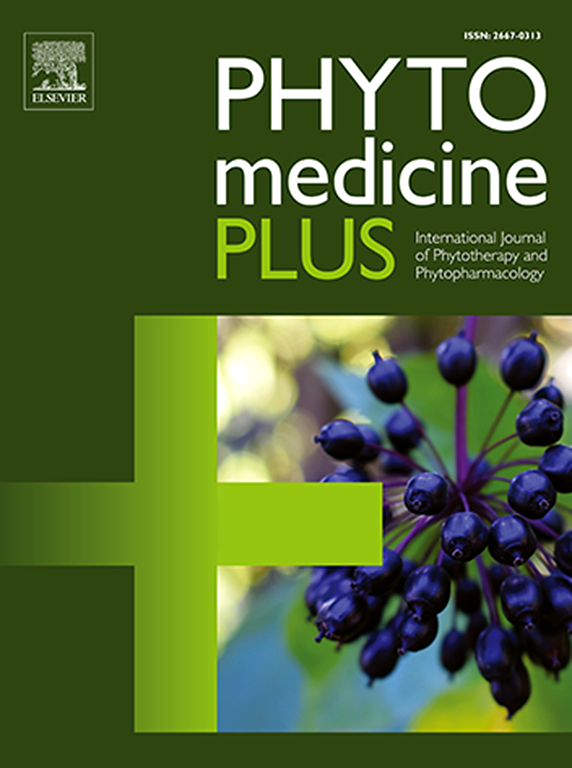Modulation of cognitive activity by plant-based extracts (Allium cepa, Coffea robusta, and Brassica oleracea) through the phosphodiesterase 4B inhibition: Insite from a Mice model study
Q3 Pharmacology, Toxicology and Pharmaceutics
引用次数: 0
Abstract
Background
Cognitive dysfunction (CD) is a growing issue worldwide, despite extensive advancements and clinical research in therapeutic strategies. A potential approach in order to treat CD entails phosphodiesterase 4B (PDE4B), which has a big impact on how well memory works.
Objective
The current investigation aimed to quantify quercetin, sinigrin, and chlorogenic acid in the extracts Allium cepa (A. cepa), Brassica oleracea (B. oleracea), and Coffea robusta (C. robusta), respectively using thin layer chromatography (TLC)-densitometry assessments and to figure out the memory-enhancing effect of combination extract (A. cepa, B. oleracea, and C. robusta) in mice.
Methods
The ethanol extracts of B. oleracea and A. cepa were prepared individually using the maceration method, while the C. robusta aqueous extract was obtained through infusion method. Quantification assessment of quercetin, sinigrin, and chlorogenic acid was carried out using TLC-densitometry. While the Morris water maze (MWM) test was used to determine the memory potential of mice. Subsequently, administering the combination extracts, memory performance was evaluated with the MWM test. Additionally, the hippocampus of the mice was analyzed against cyclic adenosine monophosphate (cAMP), protein kinase A (PKA), cAMP-responsive element-binding protein (CREB), and brain-derived neurotrophic factor (BDNF) activities using Western blot and ELISA methods.
Results
The amounts of quercetin, sinigrin, and chlorogenic acid in the extracts estimated by TLC-densitometry. The combination extracts enhanced cognition in scopolamine-induced CD in mice during behavioral test. Furthermore, the combination extracts blocked PDE4B activity and exhibited memory potential by elevating hippocampal biomarkers.
Conclusion
In summary, A. cepa, B. oleracea, and C. robusta extracts serve as an excellent sources of quercetin, sinigrin, and chlorogenic acid, respectively. The combination of these extracts was found to improve memory function in mice.

植物提取物(葱、咖啡和甘蓝)通过抑制磷酸二酯酶4B对认知活动的调节:来自小鼠模型的研究
背景认知功能障碍(CD)是一个日益严重的世界性问题,尽管在治疗策略和临床研究方面取得了广泛的进展。一种治疗乳糜泻的潜在方法需要磷酸二酯酶4B (PDE4B),它对记忆的运作有很大的影响。目的采用薄层色谱-密度法分别定量测定洋葱(Allium cepa)、甘蓝(Brassica oleeracea)和罗布斯塔咖啡(Coffea robusta)提取物中槲皮素、紫荆素和绿原酸的含量,并研究联合提取物(A. cepa、B. oleeracea和C. robusta)对小鼠的记忆增强作用。方法采用浸渍法分别提取甘蓝和菟丝子的乙醇提取物,采用浸渍法提取罗布斯塔的水提取物。采用薄层色谱-密度法定量评价槲皮素、紫荆素和绿原酸。Morris水迷宫(Morris water maze, MWM)法测定小鼠的记忆电位。随后,给予组合提取物,用MWM测试评估记忆性能。此外,采用Western blot和ELISA方法分析小鼠海马对环磷酸腺苷(cAMP)、蛋白激酶A (PKA)、cAMP响应元件结合蛋白(CREB)和脑源性神经营养因子(BDNF)活性的影响。结果薄层色谱密度法测定了槲皮素、紫荆素和绿原酸的含量。复方提取物增强东莨菪碱诱导的小鼠认知能力。此外,联合提取物阻断PDE4B活性,并通过提高海马生物标志物表现出记忆潜力。结论综上所述,cepa、B.甘蓝和C. robusta提取物分别是槲皮素、紫荆素和绿原酸的优良来源。这些提取物的组合被发现可以改善小鼠的记忆功能。
本文章由计算机程序翻译,如有差异,请以英文原文为准。
求助全文
约1分钟内获得全文
求助全文
来源期刊

Phytomedicine Plus
Medicine-Complementary and Alternative Medicine
CiteScore
3.70
自引率
0.00%
发文量
178
审稿时长
81 days
期刊介绍:
 求助内容:
求助内容: 应助结果提醒方式:
应助结果提醒方式:


